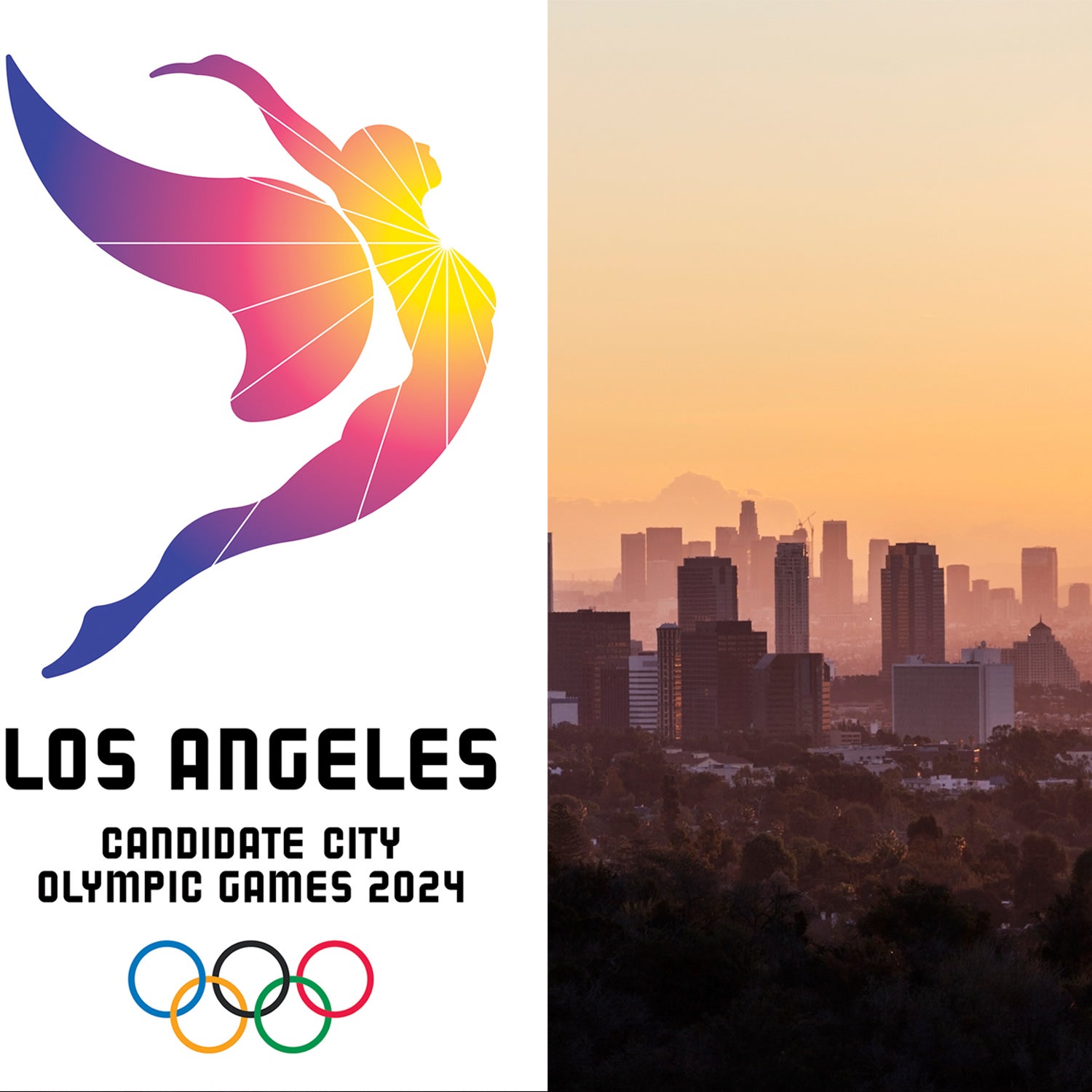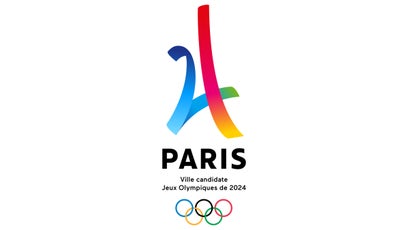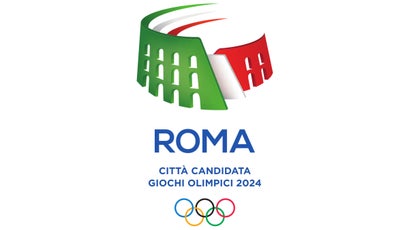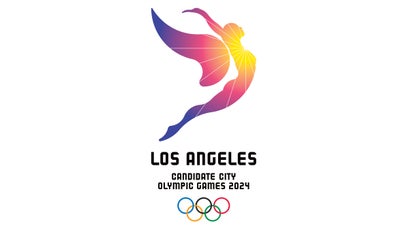Los Angeles is charging forward with the American bid to host the Summer Olympic Games in 2024, and while that may seem like a long way off, the city has been busy prepping since September 2015.╠ř
The LA24 committee, a public and private partnership among, primarily, the City of Los Angeles, the Wasserman Media Group, and the U.S. Olympic Committee, is spearheading L.A.ÔÇÖs bid for the games. On February 16, the organization released its official branding materials╠řthat will represent the city's bid effort. Along with an official slogan, ÔÇťFollow the Sun,ÔÇŁ thereÔÇÖs the all-important emblem. It portrays a flying angel, colored with a radial gradient of yellows, oranges, and purplesÔÇösimilar to those that fill L.A.ÔÇÖs skies during sunrise or sunset. Should the International Olympic Committee╠řchoose L.A. to host the 2024 games when it makes the final decision in 2017, a new emblem and slogan would be chosen.
The angel represents the only U.S. city that wants to take╠řon the increasingly controversial╠řrole╠řof hosting the games.╠řBoston was the first U.S. nominee, but Bostonians ╠řOlympic games are known to drop on host cities. Following BostonÔÇÖs withdrawal, L.A. mayor Eric Garcetti argued that the city could, as it did in 1984, host the Olympics without significant financial burden. In fact, L.A. is , and it did so twiceÔÇöin 1932 and 1984.╠řPublic support seems to be strong, too.╠řA poll conducted by Loyola Marymount University this week found that out of 2,425╠řAngelenos, 88 percent supported the Olympic bid. “IÔÇÖve never seen that in any survey IÔÇÖve done,” one of the pollÔÇÖs organizers, Brianne Gilbert,╠ř.
Los╠řAngeles╠řis competing with╠řRome, Budapest, and Paris for the final Olympic bid.╠řThe emblem could be the face of America's first successful bid for the summer hosting gig╠řsince 1996ÔÇöso we╠řasked Robert╠řNakata, the design director for╠ř, an L.A.-based advertising firm in charge of bid branding materials,╠řabout every choice the designers made to create the most meaningful emblem.
The Angel
The emblem can be interpreted as a melding of the ÔÇťCity of AngelsÔÇŁ moniker and the official ÔÇťFollow the SunÔÇŁ slogan.╠řCity officials╠řwanted to underscore L.A.ÔÇÖs ability to host people from all over the worldÔÇöit already hosts significant╠řdiaspora╠řand immigrant communities from Mexico, China, Russia, and Iran, among many others.╠řÔÇťUltimately, one of the five values of L.A.ÔÇÖs Olympic Games bidÔÇöunityÔÇödetermined the final selection”╠řof the angel as key element,╠řsays Nakata. He points to the cityÔÇÖs founders, who were of Native American, Mexican, African, and European descent, and who nicknamed it the ÔÇťCity of Angels.ÔÇŁ The series of white lines radiating from the angelÔÇÖs chest are intended to invoke the rays of sunlight that grace L.A. 284 days of the year.
The angel herself╠řis shown with arms reaching overhead and face turned upward, like a gymnast performing an uneven bar routine, about to stick a perfect landing. ÔÇťThere was intention to design the figure to be athletic and dynamic, youthful and female,ÔÇŁ he says. ÔÇťWe felt this was more in keeping with the progressive vision Los Angeles was forming for their Olympic bid.ÔÇŁ
One of the key differences between Los AngelesÔÇÖ emblem design and those of other bid cities is its literal approach. Paris and Rome have submitted highly abstract╠řrepresentations of their cityÔÇÖs most notable landmarksÔÇöthe Paris logo consists of the number 24 in a shape resembling the Eiffel Tower, and RomeÔÇÖs features the Colosseum.╠ř
Not only is Los AngelesÔÇÖ emblem a proportionally accurate depiction of a human figure, itÔÇÖs clearly female. This is unusual because figurative emblems are often deliberately designed without a clear sex.
ÔÇťChoosing female over male was a decision from the perception, and reality, that sports communication is already dominated by male athletic imagery,ÔÇŁ Nakata says. ÔÇťThe Olympics are an event that celebrates male and female athletic achievement in equal measure. Why not represent athletic achievement through female form?”
The Secret Construction
The emblemÔÇÖs curvatures are also a deliberate nod to L.A.ÔÇÖs aesthetics. A closer look at the designÔÇÖs construction shows that it harkens back to design styles popular throughout L.A. during the earlier parts of the 20th century. The outline is composed entirely of pure circles arranged over square proportions, as seen in this graphic from 72andSunny:
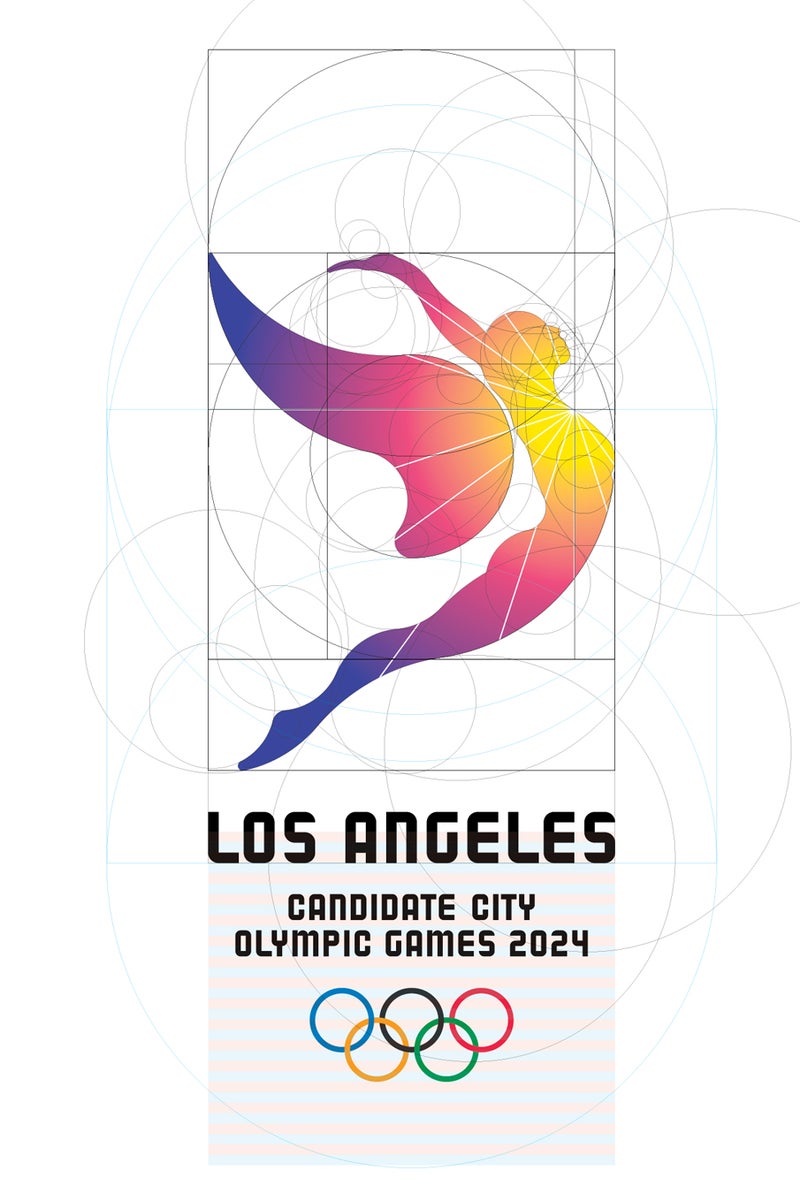
The strict use of circles as a guide for the silhouette is a throwback to Art Deco or early Modernist design, two styles that characterize many of L.A.ÔÇÖs famous buildings from the╠řcityÔÇÖs period of unprecedented growth during the 1920s and 1930s. Buildings like the ╠řand╠řL.A.ÔÇÖs ╠řare all covered with fabulously ornate designs composed of relatively simple geometric patterns. ÔÇťMost logos today tend to be more abstract,ÔÇŁ Nakata says.╠ř
The Typeface
The emblemÔÇÖs typeface╠řwhich 72andSunny designed in-house, also reflects Art Deco and Modernist influences. ÔÇťCreating a custom font based on circles and squares seemed like a logical extension of the design to create overall harmony,ÔÇŁ Nakata says. Each letter is simple and geometric, which Nakata says ÔÇťfeels like older Los Angeles, because 3D type on buildings tended to be constructed this way [in the mid-20th century].ÔÇŁ Take, for example, the uniform block text on the , which was built in the early 1930s in the Art Deco style.╠ř
The Big Reveal
The bid emblem has received a widely warm reception among Angelenos. Mayor Eric Garcetti ╠řit as a rightful representation of the ÔÇťhard work, creativity, and ingenuityÔÇŁ reflected in the Angeleno spirit. ÔÇťIÔÇÖm a fan,ÔÇŁ says Ruth Wallach, the director of the Arts and Humanities Libraries at the University of Southern California. ÔÇťIt reminds me of those smoggy sunsets L.A. does so well. Other places have good sunsets, but the smog in L.A. gives our own such magnificent color.ÔÇŁÔÇő


